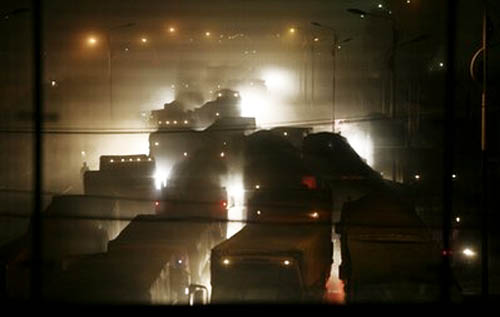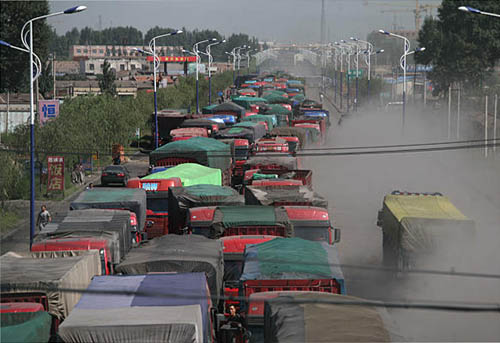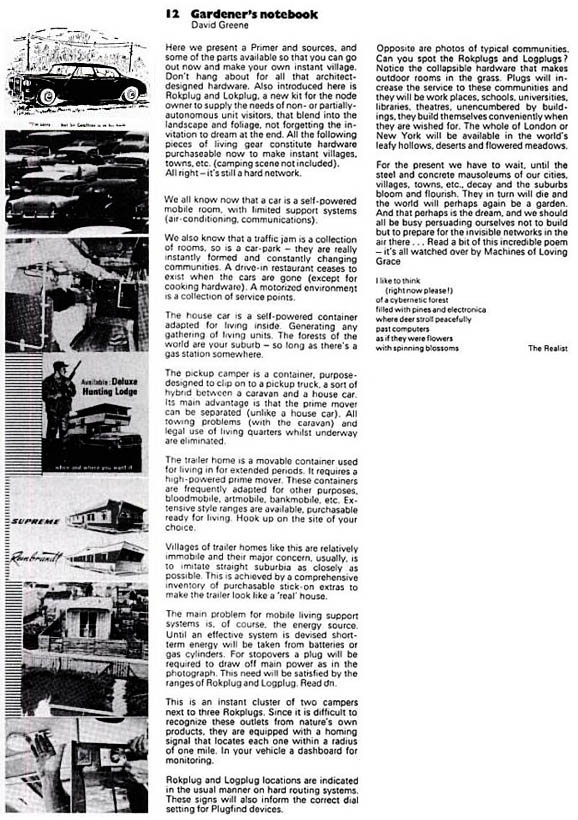A Traffic Jam is a Collection of Rooms
 [Images: The micro-culture of the motorway; images courtesy of the Associated Press/Wall Street Journal].
[Images: The micro-culture of the motorway; images courtesy of the Associated Press/Wall Street Journal].It was hard to miss the story last month that a 62-mile long traffic jam had formed in China, becoming a near-permanent feature of that nation's roadway system. It lasted nine full days, in a state of almost perfect gridlock. NPR reported that drivers simply turned off their cars and slept for 8 hours at a time.
A temporary micro-culture of the motorway soon emerged: "Villagers along Highway 110 took advantage of the jam," the Wall Street Journal reported, "selling drivers packets of instant noodles from roadside stands and, when traffic was at a standstill, moving between trucks and cars to hawk their wares. Truck drivers, when they weren't complaining about the vendors overcharging for the food, kept busy playing card games."
 [Images: The traffic jam as scene from Dante; images courtesy of the Associated Press/Wall Street Journal].
[Images: The traffic jam as scene from Dante; images courtesy of the Associated Press/Wall Street Journal].But what if another such traffic jam were to form again? Where role might there be for architecture? Clip-on awnings, zip-up tent walls, velcro-connected halls and corridors spanning car-to-car and truck door to truck door, even crawlable tunnels for kids, with mobile parks on flatbed trucks, whole canopies held down by duct tape, antennas repurposed as anchors for tarps and makeshift roofs. Outdoor cinemas are formed. Social cliques develop.
The spatial infrastructure of the permanent traffic jam kicks in: guerrilla, unfoldable, pack-into-a-backpack-able, made from lightweight materials—ripstop fabrics and military-grade rope—a city takes shape on the highway, with every car, bus, truck, and motorcycle a luxury room or repurposed piece of home furniture.
 [Image: Courtesy of Newscom and the Christian Science Monitor].
[Image: Courtesy of Newscom and the Christian Science Monitor].Lock this in place a few years and give it a postcode. Children are born there. Like Dan Hill's quip that "There are 500000 people airborne at any one time. A drifting airborne city, the size of Helsinki, a few meters tall, threaded around [the] globe," this city-on-the-road would be named, memorialized, revisited. New highways would simply thread around it, abandoning the vehicles to their stationary fate as their tires drain of air and engines stall forever.
Generations later, the fact that, down in the mud and dust beneath your metropolis, you can find abandoned frames and chassis from the city's founding traffic jam, will be impossible to believe—a run-of-the-mill urban legend. Archaeologists will argue over the best sites to excavate to find truck doors and ancient oil spills down there in the formerly mobile foundations of the city.
Even David Greene of Archigram once wrote that "a traffic jam is a collection of rooms."
 [Image: From Archigram].
[Image: From Archigram]."We also know that a traffic jam is a collection of rooms," Greene wrote in a short text called "Gardener's notebook," and "so is a car park—they are really instantly formed and constantly changing communities. A drive-in restaurant ceases to exist when the cars are gone (except for cooking hardware). A motorized environment is a collection of service points."
On the level of architecture, then, what could we do to prepare for the impending return of the near-permanent Chinese traffic jam? What prosthetic walls, floors, ceilings, and corridors—what new families of clip-on architectural forms—could we explore?
Traffic Walls™—an instant city brought to you by North Face and the GA Tech School of Architecture. Easily deployed. Houses up to 10,000 people. Machine-washable.





Comments are moderated.
If it's not spam, it will appear here shortly!
Food for thought (as usual)! If you have a chance, check out an episode of Dr. Who called "Gridlock" ... one of the premises was traffic so bad that people took years to get to their destinations (if they got there at all).
if this happens in hot climate country, there is possibility the highway will all be shaded.
Apparently EMP pulses from nuclear explosions destroy cars and other vehicles ignition systems. Imagine a small "tactical" war froze rush hour permantly. A new society of stranded travellers on freeways, stuck in departure lounges of airports far from cities and at conferences on continents far from home....
there's a short story by Julio Cortazar titled "The southern highway" which is very interestingly connected with your ideas on the traffic jam. Cortazar refers to the social relationships built among the passengers of the jammed vehicles of a fictional traffic jam outside Paris. You should read it if you have not read it yet.
Anyone who has seen the traffic jam in Jean Luc Godard's film Weekend knows that this will end in cannibalism.
actually Godard's traffic jam is said to be inspired from Cortazar' story.
I also dived into the comments to suggest Cortazar's "The Southern Highway." Ditto to what imwrong said.
I am divided on how to respond to this post, being at once inspired by the thought playground it might present and also bitten on the other ear by the thought that "Really? is this what we are spending time thinking about? No wonder architectural discourses rarely become everyday conversations..." I am not in any way discounting the value of an exercise like this, but instead find myself dreaming of putting the same intellectual effort into everyday situations that are less extreme. Not "architecture for humanity" but really just realizing that these imaginings have the power to spark something in the people that read them - dream up good ideas for lawns and you might see the really good ones showing up in your neighborhood.
Erucolindo, why not write about both?
As a planner, I would look more at how to prevent such thing from happening again or at least divert it. this post only goes to show how architects and planners thin very differently...
Mr. Manaugh,
I found your post to be quite provocative when envisioning the possibilities that this situation can create. I thought traffic jams in Los Angeles where depressing, but after seeing this story I realize the true meaning of ╥stuck in traffic╙. As a student in my final year of architecture in Los Angeles, my thesis project is focused on infrastructure and its ability to transform a city from situations like you are presenting, to something much more efficient and pragmatic like the current situation in Shanghai. Around fifteen hours apart by car, the infrastructural differences between Shanghai and Beijing are at opposite ends of the spectrum and make one wonder how conditions can be improved so dramatically in one area of a country, and yet largely ignored or allowed to fall in disrepair in another. What becomes more important to China╒s government: tourism and an outsider╒s perception of one city (Shanghai), or an improvement to a major transportation route carrying ╥essential supplies╙ to the city╒s capital? Both situations deal with the movement of millions of people, one dealing with visitors, and the other focusing on its own inhabitants. I realize there are many factors contributing to this problem, and solutions are currently underway, but for the moment it does make one wonder how a nation can be more concerned with the well being of outsiders rather than its own people.
The various potentials of architecture that you describe within this situation actually seem feasible. The creation of a community, or new city from this gridlock is an extremely interesting concept. The thought that something intended for mobility and transportation such as a highway can transform and appropriate new meaning and function in response to changing events is rational and dare I say possible? Considering the overcrowding and surges in population, expansion is inevitable. What stops squatters and this mass from appropriating new areas, including these highways, and adopting them as their new homes? Whole new communities could potentially emerge overnight, forcing recognition from the authorities. Perhaps they become nomadic along these strips of asphalt, giving new meaning to this once mobile highway. But rather than using it as a means of transportation, it becomes the destination.
Looking ahead to the future, fossil fuels and oil will not be around forever at the rates we are currently consuming them, so what will happen when these cars and modes of transportation no longer serve their initial purposes? Is there a future without vehicles? Will they become a new building material, in which an aggregation of Toyota╒s, Nissan╒s, and Honda╒s form the structure people inhabit? These radical questions may seem farfetched, but where will the future lead? The possibilities seem endless. Thank you for your inspirational posts, I look forward to many more.
Post a Comment